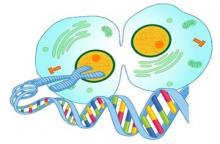During the cell cycle, cells grow and divide to form two genetically identical daughter cells. This process allows embryo development, regeneration of tissues after injury, and the constant formation of blood cells. However, impairment in this process triggers cancer development and therefore, many control mechanisms have been developed to regulate cell division. For example, DNA damage activates checkpoint mechanisms, which stop cell cycle progression, providing time for DNA repair, or, if the damage is too extensive, to carry out cell death. These mechanisms ensure maintenance of genomic stability before cell division and prevent cancer development.
Embryonic stem cells can divide indefinitely, an ability that allows embryogenesis. However, in the adult body, most cells are in a static state and no longer divide. Exceptional are cancerous cells, which re-acquire the unlimited dividing capacity of the stem cells.
In this study, we aimed to gain a deeper understanding of the genes that underlie cell cycle control mechanisms and to identify the genes that promote or inhibit growth in pluripotent versus cancer cells. To do this, we used data obtained from CRISPR libraries done on both cell types and conducted a comparative analysis of the effect of different genes on cell growth.
These libraries represent cells containing mutations in nearly all genes in the human genome. Cells harboring a mutation in a gene that is essential for cell growth will gradually disappear from the population, while cells that contain a mutation in genes that inhibit cell growth will divide faster and will be represented to a higher extent in the population. Thus, comparing the prevalence of mutations before and after culture growth indicates the function of mutant genes.
The results of our study revealed both similarities and differences between cancer and stem cells. For example, in both cases, the most essential genes for cell growth are those that participate in the S phase, where the DNA is replicated. The identity of the essential genes was also similar in both cell types, enabling us to define the core essential genes of the cell cycle. In contrast, the identity of the growth-restricting genes was quite different between the cell types. In fact, not one gene was identified as a growth-restrictor in all cells, and most genes were unique to only one cell line. This implies a large genetic variation between cell cycle regulation mechanisms of healthy and cancer cells, as well as between the cancer cells themselves.
Many cancer chemotherapy treatments are designed to damage the cancer cell division and thus kill it. However, as this study shows, there is a great genetic variation in the cell cycle between one cancer cell and another. Therefore, we believe that a deep understanding of the unique genetic features of the cell cycle in each tumor can improve appropriate chemotherapy selection and avoid unnecessary side effects
